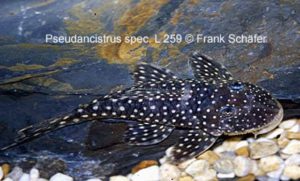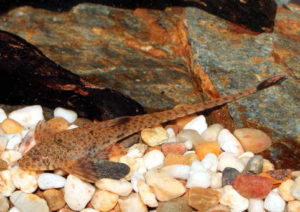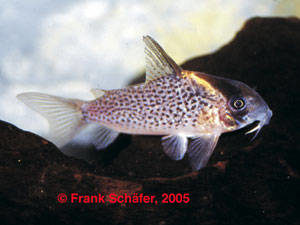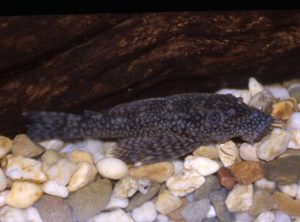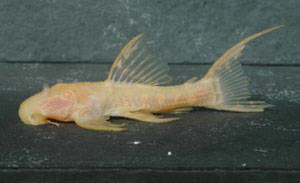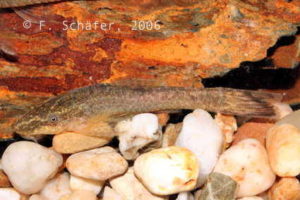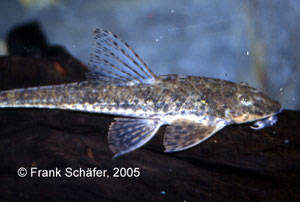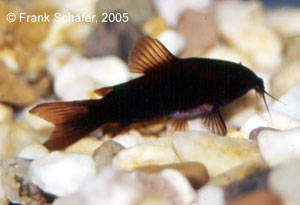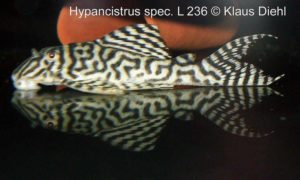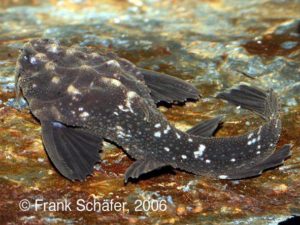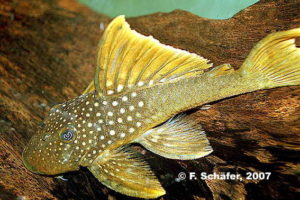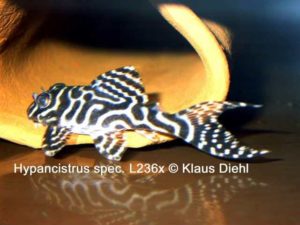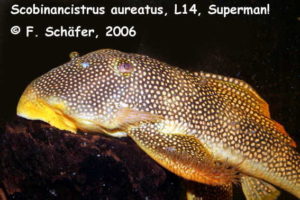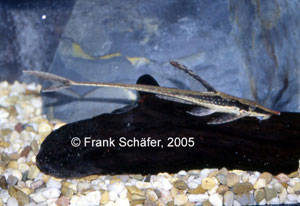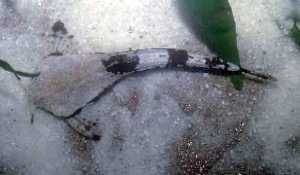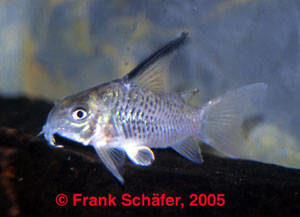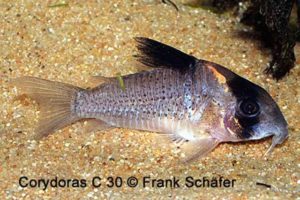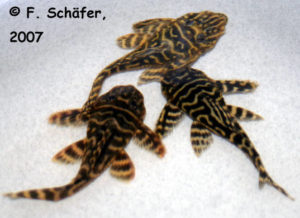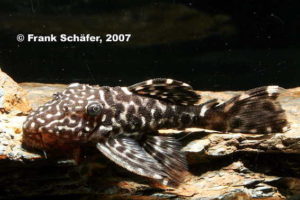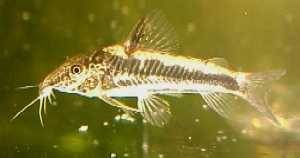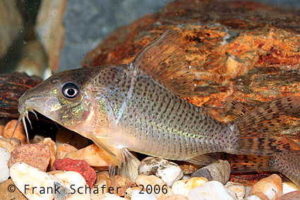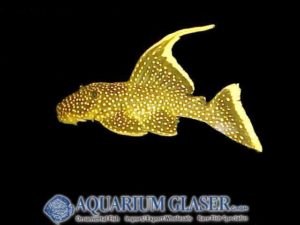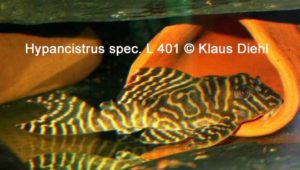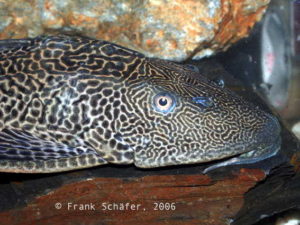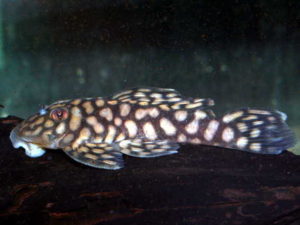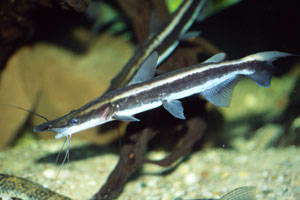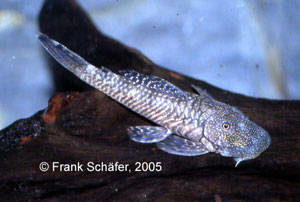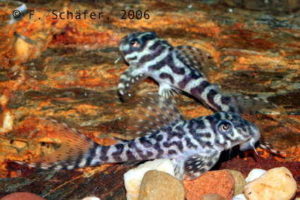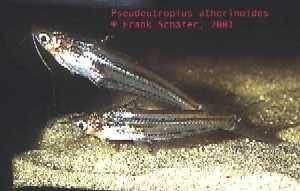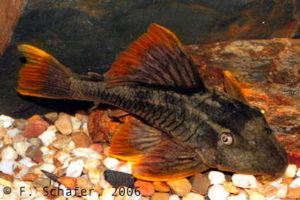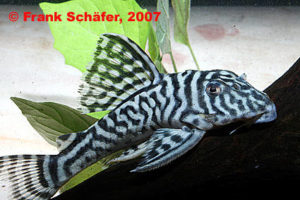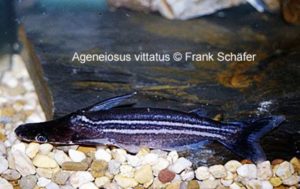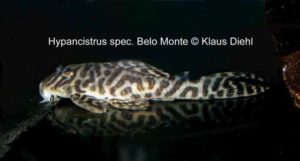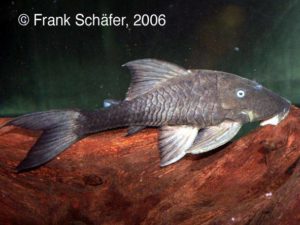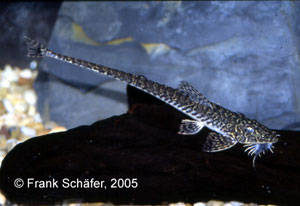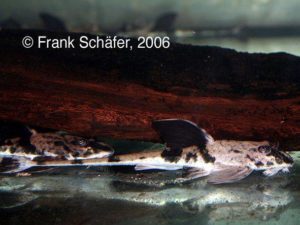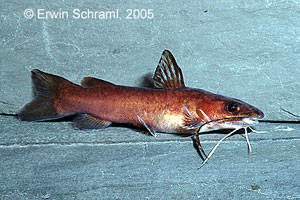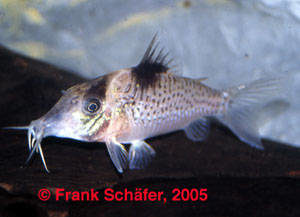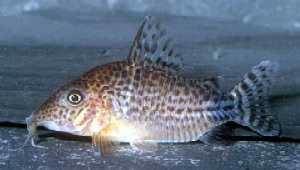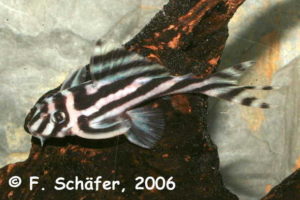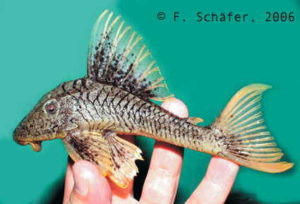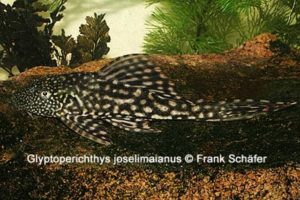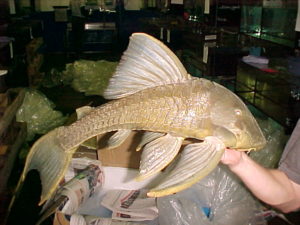Pseudancistrus spec. L 259 originates from the surrounding of the city Pimental at the Rio Tapajos. As all Pseudancistrus species the males of L 259 show a characteristic “beard” of Odontodes (dermal teeth) during the spawning season. Contrary to the popular Hypancistrus species L 259 are vegetarians. Therefore Zucchini, cucumbers and further vegetables should be […]
10. Catfishes (745)
-
-
Rineloricaria melini
As a further german bred rarity we can offer Rineloricaria melini at present. Our specimen of the probably most attractive Rineloricaria species have with 9 – 12 cm length already attained full growth and are of outstanding quality. Their origin is the area of the Rio Negro where they live in black water biotopes. Like […]
-
Corydoras sp. aff. kanei
This new and undescribed true mailed catfish differs from C. kanei by a golden band on the shoulder. The very attractive fish originate from the Rio Jamaxin (Brazil). Their final length is 5 cm. C. kanei has been bred successfully on several occasions and Seuß (Die faszinierende Welt der Corydoras, Landbuch Verlag Germany, 1997) reports […]
-
Ancistrus spec. L 111
This ancistrus, which supposedly originates from Colombia, exhibits similarities to L 89, but like L 156 has round spots arranged in a honeycomb pattern. Unlike these other two L-numbers, L 111 has a uniformly marked iris ring and light/dark grey striped pectoral fin spines. This catfish is said to grow to about 10 cm, and […]
-
Pseudoacanthicus spec. „Albino Titanic“ L 273
April 2005: Only one fish of the albino form of the well-known „Titanic Catfish“ was imported from Belem (Brazil). L 273 is normally extremely variably coloured from fish to fish. As well as splendid specimens with contrasting dark grey/yellow plus orange colouration there are also individuals that are predominantly mouse grey with black dots and […]
-
Hisonotus notatus
July 2006 From southeast Brazil we could import some rare pieces from the relationship of the popular Otocinclus species. In its homeland Hisonotus ornatus inhabits with weeds infested waters. It may not be kept too warm. 24°C probably represents the reasonable upper limit. The requirements for their maintenance do not differ from those of the […]
-
Rineloricaria sp. „Colombia“
A remarkable species which came in in one of our import from Colombia. These fishes also originate from the Rio Chacu in the northern tip of the country. Because of the many bristles of the male this species has been falsely determined as Rineloricaria latirostris. A comparison with the pictures (see Mergus Catfish Atlas Part […]
-
Corydoras sp. BLACK VENEZUELA
A very beautiful colour morph bred in Germany and a true addition to our fascinating hobby. Corydoras aeneus (this fish probably belong to this family) is one of the most common true mailed catfish in the aquaristical hobby. Originally this cory species has a large distribution in nature which ranges from Trinidad, Venezuela, Surinam, Colombia, […]
-
Ancistrus spec. L 352
Our photo shows a pair of Ancistrus spec. L 352, one with 6 – 7 cm very small remaining loricariid from the Rio Iriri. In the view from above the different body forms can easily be be recognized. This and the characteristic beard of the males makes a differentiating of the sexes quite easy. As […]
-
Hypancistrus spec. L 236
„Simply the Best “: Some days ago we could import some of this beauties. With a size of approx. 10cm the white of the here illustrated male shows a fantastic intensity. It seems that one of imported fishes is a not less beautiful female, and so we hope to be able to offer some days […]
-
Amaralia hypsiura
January 2001: At present we can offer Amaralia hypsiura for friends of the extraordinary . This rarely dealt catfish attains full growth with approx. 15 cm length. It originates from the Amzon and there it feeds mainly, as gastric examinations of freshly caught fishes documents, predominantly the spawn of other fish. Fortunately they are not […]
-
Baryancistrus demantoides L 200 High Fin
From Colombia we could import expressed beautiful L 200 High Fin. Now we have very attractive partially completely yellow colored specimen of the species Baryancistrus demantoides in stock. They will get only about 15 cm long and remain thereby substantially smaller than the also with the number L the 200 labeled Hemiancistrus subviridis. Compared with […]
-
Hypancistrus spec. L 236x
November 2006: At Christmas we would like to present a star at the catfish heaven. We can offer some offspring of the queen imperial zebra Hypancistrus spec. L 236x, a beautiful and very looked for species. They come from a German breeder, who had the luck that the two from us imported animals formed a […]
-
Scobiancistrus aureatus L 14
December 2006: Last week received we a really impressive, male Scobiancistrus aureatus. With a length of about 30 cm it might be attained full growth. The strong spines on the gill cover (Interopercularodontodes), as well as on their pectoral fins are remarkable. As most L-catfishes from the Rio Xingu they like warmer waters, for their […]
-
Sturisoma sp. „Colombia“
This for science unknown species was imported with a unique shipment from Colombia. Sturisoma sp. „Colombia“ was found in the Rio Chaco in the North of Colombia. This elegant Sturisoma species differs from the short finned species, which live on sandy habitats as well as from Sturisoma festivum by difference in colouration and body form. […]
-
Bunocephalus sp. „Black/White“
The banjocat new imported from Peru immediately attract attention due to their interesting colouring in contrast to other species of the same relation circle. Therefore some animals are almost unicoloured white while other specimens mainly show some irregular black markings. The care of this species does not differ from that of other relatives of this […]
-
Corydoras armatus „spotted“
April 2005: These beautiful animals where imported from Columbia. The literature however give Peru and Brazil as their place of origin. For more then 125 years ago these fish were described by Günther and since then hardly ever imported. The characteristic features of this catfish is the extreme long dorsal fin of which the first […]
-
Corydoras sp. C 30
Corydoras C 30, a scientifically still not described species, originates from the area of the Amazon delta (Federal State Amapa) in Brazil. In its appearance it reminds of Corydoras melanistius a further north in Surinam and Guyana occurring species. Like all Corys C 30 should be held not in a to small group (5 – […]
-
Hypancistrus spec. L 340
Freshly arrived from Colombia: the Megaclown L 340. We can offer one of the most beautiful and at the same time most variable Hypancistrus “species” in very good quality. The animals already reached maturity, so that the outstanding contrast should remain. In their requirements for maintenance they do not differ from their Brazilian cousins, warm, […]
-
Leporacanthicus sp. „NEW“
April 2007: We received a particularly beautiful easter surprise this week from Colombia. The representative of the genus Leporacanthicus illustrated here is probably the first and only specimen on the market. It reminds of the in the Orinoco occurring L 240 and L 241, as well as of Leporacanthicus cf. “Venezuela”. But its white spots […]
-
Pseudoplatystoma corruscans
The rarely traded largest shovelnose catfish Pseudoplatysoma corruscans originates from the Rio Sao Francisco in Brazil. This predator becomes quite large (approx. 180cm) and heavy (100 kg). They like to stay in groups and socialize well with rays, big charazins, cichlids or other catfishes. (Photo F. Schäfer, Text K. Diehl)
-
Corydoras baianinha
March 2003: Some weeks ago we received a few pieces of Corydoras baianinha. This extreme rare Corydoras only occurs in a little number of small streams in the south of Brasil. The population of Cordoras baianinha is very much in danger, because its living space was already largely distroyed by environmental pollution and forest clearing! […]
-
Corydoras sp. C 71
August 2006: With Corydoras spec. C 71 we could import a further rare species from Brazil. They originate from the Rio Arua in the Federal State Para. With a final size of 6 cm they belong to the medium sized Corys. The requirements for their maintenance might be the same as for other Corydoras species. […]
-
Baryancistrus sp. L-81 HIGHFIN
September 2003: This week we received from Brasil a really unique fish: L-81 HIGHFIN. Our supplier advised us to send this fish and it really was worth waiting….was it not?(Photo F. Schäfer, Text K. Diehl)
-
Hypancistrus spec. L 401
This in the DATZ 12/05 introduced very beautiful Hypancistrus variant is at present in a small number available. The animals remind in their habitus of L 333 and with these are also occasionally confounded. In the figure they are more delicate, somewhat more stretched and reach only one overall length of maximally 12 cm, while […]
-
Liposarcus pardalis
Liposarcus pardalis has enormous area of origin that enclosure nearly the entire Amazon basin. It is found in different waters types, herefrom results a large adaptability for the maintenance in aquaria. According to the size (> 40cm) enormous food quantities are consumed. In Southeast Asia they are bred in large numbers and so wild caughts […]
-
Spectracanthicus (= Oligancistrus) zuanoni L 354
Spectracanthicus zuanoni L 354 originates from Rio Xingu and the Rio Iriri in Brazil. It has been described scientifically only in 2014 (see http://www.aquariumglaser.de/en/archiv.php?news_id=1195). The fish belongs to the same species as L 20, with however clearly larger white marks, so that the design reminds of a black net on a bright background. The reddish, […]
-
Sorubim lima
The shovel nose catfish is a classical appearance in the hobby. Even in the most common aquarium shops you can find this species as juveniles with a length between 8 and 10 cm. These fish are very appealing when they are small, but one should reconsider an impulsive buy here because these fish can grow […]
-
Chaetostoma pearsei L 187
This Chaetostoma species is imported in regular intervals from the upper Orinoco through Puerto Ayacucho. This catfish is very difficult to differentiate from L 147 and L 188. L 188 has often described in the literature as C. nudirostre. C. pearsi lives in fast streaming mountain brooks and therefore needs in the aquarium oxygen rich […]
-
Hypancistrus spec. L 66 „King Tiger“
As one of the early imported representatives of the so-called L-number catfishes L 66 has already an unbroken popularity. At present we can offer beside wild caughts also very beautiful german breds. Such bright grounded L 66 are at least as attractive as the most „newer“ Hypancistrus species. With a final size of approx. 15 […]
-
Pseudeutropius atherinoides
The „shark cats“ of the genus Pangasius are highly seeked for aquarium fishes, because their swimming behaviour reminds one on a shark. Sadly all species grow very fast and none of the species stays smaller than 50 cm, some even reach 150 cm or even more. For some time now so-called „mini-pangasius“ are introduced to […]
-
Cochliodon sp. YELLOW SEAM L 360
From the Rio Jamanxim in Brazil we could import a small number of L 360 with nice yellow-orange fins. They are unproblematic in the maintenance need however a high portion of vegetables in their food. Similar as Panaques this over 30 cm large growing species specieseats large quantities ofr bogwood. A high performance filtering unit […]
-
Hypancistrus spec. NEW
September 2006: Latterly we received this very rich contrasted male of an unknown Hypancistrus species. Certainly here exists a similarity to L 333 and also Hypancistrus spec. Xingu. It gets more and more difficult to attach single fishes to existing L numbers or to a known Hypancistrus species, because there are not enough hard criteria […]
-
Ageneiosus vittatus
July 2002: For the first time we could import Ageneiosus vittatus from Peru. Slopehead catfish of the genus Ageneiosus are particularly noticeable by its strongly flattened head. These predators can reach an overall length of 30 cm. For the maintenance large basins are necessary. A dark bottom, some stones and bogwood should be brought in […]
-
Hypancistrus spec. „Belo Monte“ (L 287, L 399, L 400)
The denomination of this beautiful Hypancistrus is still disputed. It run long time under the number L 287, so it is named on our stock list. Recently it is called L 399 and/or L 400, the origin is the Rio Xingu, where it gets caught in the neighbourhood of Belo Monte. This species belongs into […]
-
Panaque cochliodon
December 2005: After years when no Panaque cochliodon (Panaque suttoni, P. suttonorum) were imported, now again few individuals reach us. Whether environmental problems or the civil war in parts of Colombia are responsible for their non appearence, can not be judged from a distance. We are glad to see this in former times not rare […]
-
Crossoloricaria cf cephalaspis
The 5 species of the genus Crossoloricaria are all looking very similar to the flounder Loricariid genus Pseudohemiodon. These fish have as well a flattened body form, small eyes lying distally on the triangularly formed head. The difference between these two genii is the missing of the ventral bony plates of Crossoloricaria. Only at the […]
-
Loricaria simillima
Loricaria simillima has a very wide distribution in South America. It is found in the Orinoco-, Amazon- and La Plata basins. A result of this large area many different color forms are known, which differ clearly regarding coloration and pattern. The species occurs in different water types. Black water forms are more demanding in maintenance […]
-
Phyllonemus typus
The Spatula-barbeled Catfish, endemic for Lake Tanganyika, has a very special way of reproduction for catfish: they are biparental mouthbreeder. This small catfish is the only representative of its genus and can be easily distinguished by the long barbels on both sides of the upper jaw, which are ending into a spatula form. The total […]
-
Corydoras ephippifer
This true mailed catfish species was imported from Belem (Brazil). The latin name „ephippifer“ is a combination from „ephippium“ (lat. = saddle) und „ferre“ (lat. = bearing) referring to the black spot on the basis of the dorsal fin. The animals reach a maximal length of 6 cm. They should be kept in a group. […]
-
Corydoras spectabilis
In fact we have ordered Corydoras guapore from Manaus,…but what we got was totally different. We got for the first time Corydoras spectabilis, which is found in the upper Rio Guaporé around Vila Bela. (Photo E. Schraml, Text Aquarium Glaser)
-
Hypancistrus zebra L 46 „Double Tailfin
November 2006: At present we can offer beside „normal “German bred zebras (surely the most demanded of all L-numbers) an individual with a doubled lower caudal fin. This change of the fin is probably to be led back on a disturbance in the embryonic development. If someone hopes to breed a race of „veil tailed […]
-
Cochliodon spec. var. marbled L 360a
From the drainage basin of the Tapajos arrived a new, until now not imported loricariid catfish at our facility. Body form and yellow fin seams remind strongly of L 360, the body and parts of the fins however exhibit a veining atypical for L 360. In their maintenance requirements they might probably not differ from […]
-
Glyptoperichthys joselimaianus L 1, L 22
Glyptoperichthys joselimaianus the “White Spot – Glycopterichthys” originates from the Rio Araguaia, one of the main tributaries of the Rio Tocantins in Brazil. There it inhabits different habitats, it was found e.g. on deadwood and also on flooded meadows. Natural water conditions (white water) do not have to be copied for maintenance, L 1 are […]
-
Panaque spec.
June 2006: Just freshly arrived! Also for „old stagers“ there are again and again genuine surprises with us. In a shipment from Peru we received today several particularly delicate Loricariids, which represent a petite alternative to the frequently maintained Hypancistrus species. However their size of (50 – 70 cm) probably exceeds the possibilities of most […]
- « Previous Page
- 1
- …
- 6
- 7
- 8





